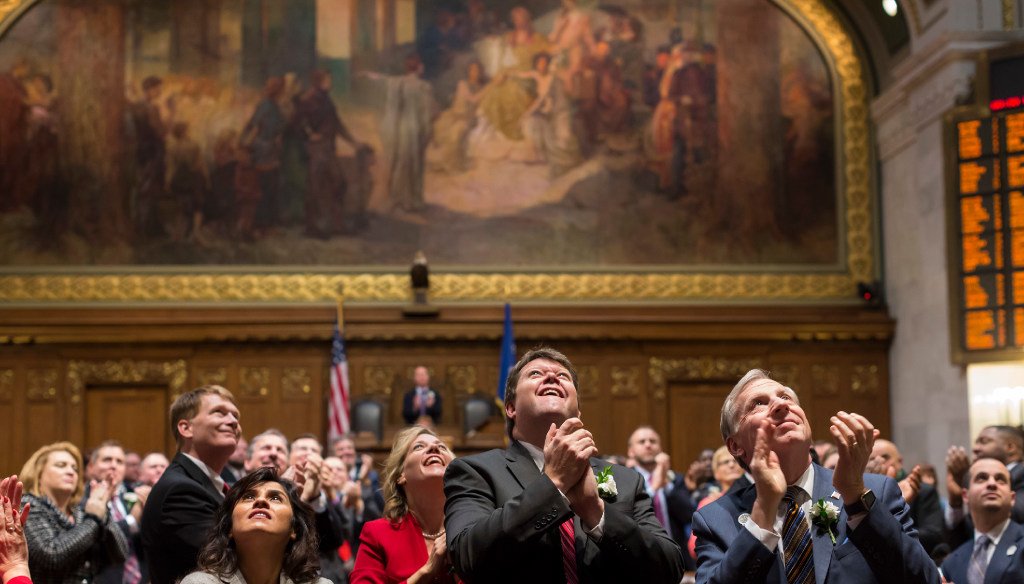



State representatives applaud former Assembly Leaders seated in the gallery during the 100th opening ceremony of Wisconsin State Legislature Jan. 3, 2017, in Madison, Wis. (Photo © Andy Manis)
Wisconsin’s electoral maps that were drawn in 2011, when Republicans controlled both the legislative and executive branches, tilted heavily in favor of GOP control.
Bewley argues that because Wisconsin has split fairly evenly in recent statewide elections between Republicans and Democrats, that split should be reflected in the state Legislature.
But analysts say that the state’s political geography — more Democrats clustered in cities; more Republicans spread out over rural areas — wouldn’t allow for an even split, even if the maps were redrawn without gerrymandering.
Wisconsin’s Republican and Democratic lawmakers never agree on much, but nothing turns up the heat like redistricting time.
Redistricting is the once-a-decade process through which the state gets chopped into pieces based on new census numbers. That helps determine who represents you in local, state and national positions, so the stakes are high.
In Wisconsin, Republicans controlled both the legislative and executive branches the last time these maps were drawn, in 2011. The gerrymandered districts approved by former Gov. Scott Walker locked in GOP control of the state Legislature and slashed the number of competitive seats.
With a veto from Gov. Tony Evers, a Democrat, the maps are destined to head to the courts.
Before the Nov. 18, 2021 veto, Senate Minority Leader Janet Bewley, D-Mason, blasted the Republicans’ new maps as continuing to give them a major advantage.
During the debate on the maps, Bewley made an argument she later included in a Nov. 5, 2021 news release: that the Legislature should reflect the state’s partisan divide.
"Wisconsin is almost equally divided on partisan lines," she wrote, therefore the new maps should be drawn to "represent that fifty-fifty split."
That may sound reasonable, but the political geography of Wisconsin dictates otherwise.
Let’s take a look.
Bewley is correct that the Badger State has split fairly evenly in a number of recent elections between Republicans and Democrats.
When asked for evidence of her claim, staffer Joseph Hoey sent a breakdown of votes in a handful of presidential, state Supreme Court, U.S. Senate and gubernatorial races in Wisconsin from 2014 on.
Closest, of course, were the margins between candidates in the 2020 presidential election and the 2018 race for governor.
In 2020, former President Donald Trump lost to President Joe Biden by a margin of about 20,000 votes.
In 2018, Evers bested Walker by less than 30,000 votes.
Other races Hoey cited, while their margins were less razor-thin, were all within a difference of a handful of percentage points.
But that doesn’t mean seats can be drawn to generate a roughly even number of Republicans and Democrats in the state Legislature. When their votes have to be split into districts for state lawmakers, Republicans have a geographical advantage.
Democratic voters are disproportionately concentrated in blue cities like Milwaukee and Madison. This confines their voting power to fewer districts. Republican voters, on the other hand, are distributed across a wider area, giving them a larger number of favorable seats. In effect, those votes are distributed more efficiently, an Oct. 7, 2021 analysis from the Milwaukee Journal Sentinel found.
Voters in Wisconsin are also more sorted now than in the past into politically one-sided communities, which often result in one-sided districts, according to the same analysis.
Some of this is impacted by gerrymandering. The 2011 maps made some districts redder and safer for the Republicans holding the seats. They made others much more blue — which "packed" Democratic voters into a smaller number of seats, reducing their voting power.
The GOP’s natural advantage is reflected in a Feb. 11, 2021 analysis by research fellow John Johnson of the Marquette Law School Lubar Center: Even prior to the 2011 redistricting, Democrats needed to win the state by roughly two or three percentage points at the top of the ticket to have a shot at winning legislative majorities.
"Any plausible Assembly map for the 2020s would probably still create a system where Republicans would win a majority of the seats even when Democrats win 51% of the vote statewide," Johnson wrote. "But a non-gerrymandered map would increase, at least somewhat, the number of seats that either party could realistically win. A fairer map would also lower the size of the statewide victory Democrats require to win control of the Assembly."
Bewley claimed the state’s fairly even partisan split should be represented in the state Legislature.
She gives proper nod to Wisconsin’s general purpleness, but misses widely on her broader point.
Because Republicans tend to be more spread out while Democrats tend to be more clustered, the GOP has a natural advantage in elections for state lawmakers. A non-gerrymandered map could increase the number of competitive seats, but it still wouldn’t create an even split.
A rating of Mostly False indicates that the statement contains an element of truth but ignores critical facts that would give a different impression.
That fits here.
Milwaukee Journal Sentinel, "A look back at the 2011 gerrymander and what it tells us about the redistricting fight to come," Oct. 7, 2021
Wisconsin Public Radio, "Wisconsin Senate approves GOP-backed redistricting plan," Nov. 8, 2021
WisPolitics, Bewley press release, Nov. 5, 2021
Email exchange with Joseph Hoey, Bewley’s office, Nov. 15, 2021
Associated Press, "Completed Wisconsin recount confirms Biden’s win over Trump," Nov. 30, 2020
New York Times, "Tony Evers wins Wisconsin governor’s race; Scott Walker concedes," Nov. 7, 2018
Marquette University Law School, "Why do Republicans overperform in the Wisconsin state Assembly? Partisan gerrymandering vs. political geography," Feb. 11, 2021
In a world of wild talk and fake news, help us stand up for the facts.
